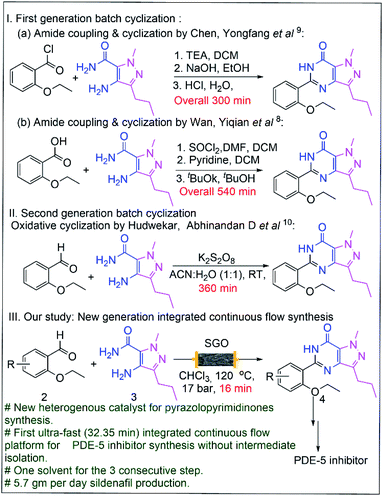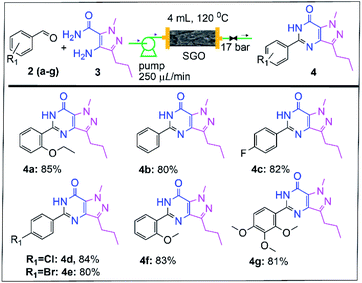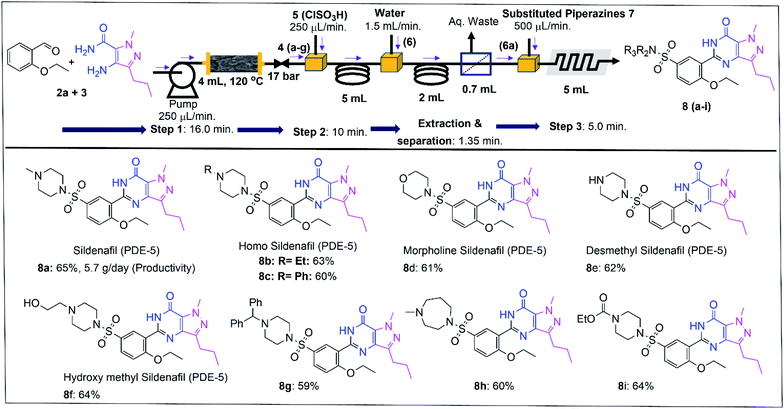 Open Access Article
Open Access ArticleSulphonated graphene oxide catalyzed continuous flow synthesis of pyrazolo pyrimidinones, sildenafil and other PDE-5 inhibitors†
Vinay Kumar Sthalamab,
Bhushan Mahajanab,
Purushotham Reddy Karraa,
Ajay K. Singh *ab and
Srihari Pabbaraja
*ab and
Srihari Pabbaraja *ab
*ab
aDepartment of Organic Synthesis and Process Chemistry, CSIR-Indian Institute of Chemical Technology, Hyderabad, 500007, India
bAcademy of Scientific and Innovative Research (AcSIR), CSIR-Human Resource Development Centre (CSIR-HRDC) Campus, Ghaziabad 201002, Uttar Pradesh, India. E-mail: srihari@iict.res.in
First published on 21st December 2021
Abstract
Sulphonated graphene oxide was used for cascade condensation and cyclization reactions towards accessing substituted pyrazolo pyrimidinones. Further, sulphonation and amination reactions were integrated through continuous flow chemistry to access PDE-5 inhibitors. Herein, we report a simple continuous synthetic platform that reduce tedious manual operations and accelerate the synthesis of several potent inhibitors of phosphodiesterase type-5. The developed platform enabled us to perform one-flow multi-step, multi-operational process to synthesize the PDE-5 inhibitors such as sildenafil and its analogues in 32.3 min of the reaction time, with minimal human intervention and single solvent.
Pyrazolo pyrimidinone is a fundamental structural analogue of nucleobase purines (Fig. 1) and is one of the most versatile adenosine receptor antagonists. This scaffold has attained global importance because of a wide range of pharmacological properties1–4 such as, anti-bacterial, anti-cancer, antifungal activity, anti-microbial, fungicidal and pesticide, etc., making it an interesting synthetic target for organic chemists. In recent years, there are numerous synthetic methods and tools developed for the manufacturing of pyrazolo pyrimidinone based drugs like Viagra or Sildenafil (PDE-5 inhibitor).5,6 The first batch protocol for the formation of pyrazolo pyrimidinone is dated on 1996,7 wherein aromatic acid8 or acid chlorides9 were used for the cyclization reaction which was attempted in a two-step sequence amidation followed by oxidative cyclization and was promoted by excess amounts of SOCl2 or bases (TEA, NaOH, pyridine & tBuOk) at reflux temperature. The recent developments over a decade in the oxidative cyclization have demonstrated the use of simple and commercially available aromatic aldehydes as substrates in the presence of oxidants like K2S2O8,10 H2O2, K2S2O5, etc. in stoichiometric amounts. On the other hand, to minimize the usage of oxidants, several novel transition metal (Pd, Cu, In, Sn) catalytic reactions under homogeneous and heterogeneous conditions were employed.11
Later on, a series of methods have been developed for coupling and cyclization reactions.12–15 The other reagents used for the transformation include H2O2/NaOH, HPOCl3, PCl5, K2S2O5, NaHSO3, Al2O3, t-BuOK/t-BuOH, PPA, AcOH etc. in stoichiometric amounts.16–19 Though the batch protocols are assisted by using various reagents, the reaction systems in stoichiometric amounts results in generation of huge side products and waste. Batch process have a low surface to volume ratio and inefficient mixing, results in longer reaction times (4–24 h) to complete the reaction with off-quality product and are hence inappropriate for automation.20–22
The existing batch process involves labour and cost-consuming multiple operational processes that need to be absolutely avoided by the chemical industry. In recent years, to minimize the wastage in the chemical reaction, heterogeneous catalysis with packed bed systems is well explored. Therefore, fabrication of suitable heterogenous catalyst, continuous-flow, oxidant free, one-flow, one solvent, with minimal human intervention, towards accessing broad range of substrates in fast manner in reactors is highly desired for PDE-5 synthesis.23–27
As proof of the concept for the PDE-5 inhibitor synthesis under continuous flow process system, a model reaction between 2a and 3 was attempted in flow manner. To optimize the reaction conditions for the continuous flow process system, the feasibility reaction was carried out by infusing the solution containing reactants with the solvent(s) under a stoichiometric molar ratio. The stock solution was passed through Amberlyst® 15 (1.0 g) filled in SS-cartridge (id = 7 mm, length 100 mm, vol = 4 mL) at 120 °C with 17 bar pressure with a flow rate of 250 μL min−1 (retention time 16 min) which typically led to generation of the yellowish solution with 20% yield of the desired product 4a (Table 1, entry 1). The result was also similar when GO was used affording 23% yield of the desired product along with major amount of unreacted starting materials (Table 1, entry 2).
| Entry | Flow rate (μL min−1) | Reagent | Time (min) | Yield (%) |
|---|---|---|---|---|
a Reaction conditions: feed solution molar ratio [2a![[thin space (1/6-em)]](https://www.rsc.org/images/entities/char_2009.gif) : :![[thin space (1/6-em)]](https://www.rsc.org/images/entities/char_2009.gif) 3 3![[thin space (1/6-em)]](https://www.rsc.org/images/entities/char_2009.gif) : :![[thin space (1/6-em)]](https://www.rsc.org/images/entities/char_2009.gif) CHCl3 (1 CHCl3 (1![[thin space (1/6-em)]](https://www.rsc.org/images/entities/char_2009.gif) : :![[thin space (1/6-em)]](https://www.rsc.org/images/entities/char_2009.gif) 1.1 1.1![[thin space (1/6-em)]](https://www.rsc.org/images/entities/char_2009.gif) : :![[thin space (1/6-em)]](https://www.rsc.org/images/entities/char_2009.gif) 236)]; reagent (1 g) filled SS-cartridge (id = 7 mm, length 100 mm, vol = 4 mL); temperature 120 °C; under 17 bar pressure; yields are based on the isolated yields.b Amberlyst® 15 hydrogen form. 236)]; reagent (1 g) filled SS-cartridge (id = 7 mm, length 100 mm, vol = 4 mL); temperature 120 °C; under 17 bar pressure; yields are based on the isolated yields.b Amberlyst® 15 hydrogen form. |
||||
| 1 | 250 | Amberlystb | 16 | 20 |
| 2 | 250 | GO | 16 | 23 |
| 3 | 250 | SGO | 16 | 87 |
| 4 | 500 | SGO | 08 | 70 |
| 5 | 100 | SGO | 40 | 85 |
We anticipated that incorporating a hard acid –SO3H functional group into the graphene oxide backbone, the catalytic efficiency could be further improved. In this context, we have prepared the sulphonated graphene oxide (SGO)28 (see details in ESI†) and examined its reactivity. To further elucidate the optimized reaction parameters, we have investigated several experiments at different conditions such as various flow rates (10 μL min−1, 50 μL min−1, 100 μL min−1, 250 μL min−1, 500 μL min−1, 1 mL min−1 & 2 mL min−1), at different temperatures (60 °C, 80 °C, 100 °C, 120 °C & 140 °C), at different pressures (5 bar, 10 bar, 17 bar and 32 bar) and using different solvents (CHCl3, 1,2-DCE, DCM & tBuOH) respectively. We noticed that under lower temperature & pressures, no reaction or low yields was observed (see the ESI, Table S1,† entries 5–9), which may be attributed due to the insufficient energy and shorter duration of time for the cyclization reaction to occur. Finally, we have achieved optimized continuous flow conditions to yield 85% of compound 4a (Table 1, entry 3) in CHCl3 as a solvent at 120 °C temperature and 17 bar pressure with a flow rate of 250 μL min−1. Further, to check the long-term durability of SGO, we run the system continuously for 30 h and obtained 4a with ca 0.67 mmol h−1 productivity. It is worth to mention that the SGO works efficiently for the one-pot synthesis i.e., the condensation and cyclization reaction without an external oxidant (see the ESI Comparative Table S2,† entries 1–6). The detailed mechanistic study to check the oxidative pathway (involvement of aerial oxidation) is discussed (see ESI Mechanistic study, Fig. S7†).
After optimization of reaction conditions for the synthesis of pyrazolo pyrimidinones, we further explored the substrate scope and limitations of this strategy. Thus, several substituted aryl aldehydes with F, Cl, Br and –OMe (2c–g) and un-substituted aldehyde 2b were investigated under optimized conditions to afford the corresponding pyrazolo pyrimidinones with 80–85% yield (4a–g, Fig. 2).29
After completion of the step-1 cyclization reaction and validation of SGO activity, further two step protocols, the sulphonation followed by amine coupling reaction to obtain the PDE-5 inhibitors were needed to be performed. In conventional batch process for the sulphonation reaction, chloro sulphonic acid, which is highly hygroscopic, corrosive and powerful lachrymatory agent is employed.30 Apart from this, the reaction also requires additional energy for maintaining the reactor temperature from 0 °C to −10 °C. To minimize the toxic exposure of chloro sulphonic acid and to maintain the ambient reaction temperature, flow technique was employed.31 In this regard, individual sulphonation reaction was optimized under the continuous flow for the synthesis of compound (6a) (see the ESI, Table S3,† entry 4). Herein, we observed the sulphonated product 6 was obtained in 10 min, at ambient temperature with 88% yield (see the ESI, Table S3,† entry 4). As shown in (ESI Table S4†), further to remove the excess amount of the chloro sulfonic acid which is present in the reaction medium and also to minimize the post-downstream purification process, we further appended continuous aqueous quenching, and droplet-based extraction strategy32–37 (see the ESI; Fig. S8 and Table S4†). The clean separation was achieved after regulating the back pressure and allowing the transmission of the integrated process for the sulphonation (10.0 min), and extraction/separation (1.3 min) of pyrazolo pyrimidinone with excellent yields (∼88% yields) resulting in ca. 0.32 mmol h−1 productivity. It was observed that the conventional batch process for similar reaction recorded almost same yield in longer reaction time (4–6 h) and at low temperature (0 °C to −10 °C) to furnish the desired product.
Next, we focused for developing the continuous flow amination process to synthesize the sulphonamide API38 compounds such as sildenafil, and other PDE-5 inhibitors. The sulphonated product 6a was used as a model compound and treated with N-methyl piperazine to produce 8a. After investigating several reaction conditions, we were gratified to observe that the results are feasible and 94% yield of 8a was obtained in just 5 min of retention time at ambient temperature. Under this optimized condition, 8a was obtained with a ca. 0.6 mmol h−1 productivity (see the ESI, Fig. S9 and Table S5,† entry 6). After the successful completion of the individual optimization reactions in continuous flow manner, we have planned to build a fully integrated continuous automated platform for API sildenafil free base and its analogues synthesis. Fig. 3 illustrates a basic set-up to the integrated continuous flow synthesis reactor. Using this platform, the reactants substituted aldehyde 2a and amine 3 were introduced to a micro-reactor39 to get sildenafil (8a) in overall moderate yield (∼65%) (Fig. 3) in 32.35 min (condensation and cyclization reaction (16.0 min), in situ sulphonation (10 min), quenching, extraction (1.0 min) and separation (0.35 min), and followed by amination (5 min) resulting in ca. 0.5 mmol h−1 productivity. Thus, we were able to produce 5.7 g of sildenafil after running the reaction for 24 h. Finally, after the development of a fully integrated process for the synthesis of sildenafil, we were interested in testing the scope and limitation of our newly developed platform. As shown in Fig. 3, we have successfully developed the micro-flow conditions that have emerged as a superior alternative for the cascade PDE-5 inhibitor synthesis obtained by batch protocol (see the ESI Comparative Table S6,† entries 1–8). A range of amino substrates (substituted piperazines and morpholine) were found to be well tolerated furnishing the corresponding substituted PDE-5 inhibitors in 59–65% overall yield. In contrast, a series of PDE-5 inhibitors such as sildenafil, homosildenafil, hydroxy-methyl sildenafil, and morpholine sildenafil, des-methyl sildenafil etc., are accessible quickly in a continuous flow process on small scale as well as large scale in one-solvent system. The present protocol avoids multi-solvents/multi-solvent system and highly laborious post-synthetic work-ups in comparison with the traditional batch methods including many unusual unit operations that takes several hours/days to produce them.
In conclusion, we have developed a new and highly efficient integrated continuous flow platform for the synthesis of biologically active pyrazolo pyrimidinones, sildenafil and other PDE-5 inhibitors. The system is multi-operational, time-effective, scalable, real-time in fast manner in 32.35 min reaction time in one solvent providing an improved 65% overall yield with 5.7 g day−1 productivity of sildenafil. The integrated machine has all the desired attributes required in continuous manufacturing process development. To our best of knowledge, this integrated continuous flow process will be useful in small scale as well as large scale industrial synthesis of sildenafil and other analogue PDE-5 inhibitors.
Conflicts of interest
There are no conflicts to declare.Acknowledgements
S. V. K. is thankful to Sai Life Sciences Limited, Hyderabad, for providing the opportunity to pursue a PhD course at CSIR-IICT through AcSIR. Financial assistance received from the DST and Science and Engineering Research Board (SERB) by sponsoring project no. DST/INSPIRE/04/2016/000247 is gratefully acknowledged. CSIR-IICT, Hyderabad, has filed a patent on the design of a reactor and an integrated continuous flow micro-total process system for the synthesis of sildenafil reported herein. IICT manuscript communication No. IICT/Pubs./15/149.Notes and references
- A. M. Fouda, H.-A. S. Abbas, E. H. Ahmed, A. A. Shati, M. Y. Alfaifi and S. E. I. Elbehairi, Molecules, 2019, 24, 1080 CrossRef PubMed.
- Y. Liu, Y. Gao, J. Liu, Y. Tan, Z. Liu, C. Chhotaray, H. Jiang, Z. Lu, G. Chiwala, S. Wang, G. Makafe, M. M. Islam, H. M. A. Hameed, X. Cai, C. Wang, X. Li, S. Tan and T. Zhang, Nat. Commun., 2019, 10, 524 CrossRef CAS PubMed.
- A. Rahmouni, S. Souiei, M. A. Belkacem, A. Romdhane, J. Bouajila and H. Ben Jannet, Bioorg. Chem., 2016, 66, 160–168 CrossRef CAS PubMed.
- J. Ram, H. N. Pandey and L. Mishra, Arch. Pharm., 1979, 312, 586–590 CrossRef PubMed.
- M. A. Shaaban, Y. A. M. M. Elshaier, A. H. Hammad, N. A. Farag, H. Hassan Haredy, A. A. AbdEl-Ghany and K. O. Mohamed, Bioorg. Med. Chem. Lett., 2020, 30, 127337 CrossRef CAS PubMed.
- M. A. Gouda and W. S. Hamama, Synth. Commun., 2017, 47, 1269–1300 CrossRef CAS.
- K. Terrett Nicholas, S. Bell Andrew, D. Brown and P. Ellis, Bioorg. Med. Chem. Lett., 1996, 6(15), 1819–1824 CrossRef.
- W. Yiqian, K. Hengming, C. Gong, W. Huanchen, Z. Xinhai and Z. Zhanchao, Patent China, CN102020645 A, 2011 Search PubMed.
- C. Y. Fang, H. Xiang, Y. Hao, Y. Xufeng and C. Jiang Qibin, Patent China, CN108558890 A, 2018 Search PubMed.
- A. D. Hudwekar, G. L. Reddy, P. K. Verma, S. Gupta, R. A. Vishwakarma and S. D. Sawant, ChemistrySelect, 2017, 2, 4963–4968 CrossRef CAS.
- N. Mulakayala, B. Kandagatla, Ismail, R. K. Rapolu, P. Rao, C. Mulakayala, C. S. Kumar, J. Iqbal and S. Oruganti, Bioorg. Med. Chem. Lett., 2012, 22, 5063–5066 CrossRef CAS PubMed.
- M. Bakavoli, G. Bagherzadeh, M. Vaseghifar, A. Shiri, M. Pordel, M. Mashreghi, P. Pordeli and M. Araghi, Eur. J. Med. Chem., 2010, 45, 647–650 CrossRef CAS PubMed.
- S. Mohammed, R. A. Vishwakarma and S. B. Bharate, J. Org. Chem., 2015, 80, 6915–6921 CrossRef CAS PubMed.
- H. W. Hamilton, D. F. Ortwine, D. F. Worth and J. A. Bristol, J. Med. Chem., 1987, 30, 91–96 CrossRef CAS PubMed.
- M. A. Gouda and W. S. Hamama, Synth. Commun., 2017, 47, 1269–1300 CrossRef CAS.
- R. J. Abdel-Jalil, M. Khanfar, K. Abu-Safieh, S. Al-Gharabli, M. El-Abadelah and W. Voelter, Monatsh. Chem., 2005, 136, 619–624 CrossRef CAS.
- S. Schenone, M. Radi, F. Musumeci, C. Brullo and M. Botta, Chem. Rev., 2014, 114, 7189–7238 CrossRef CAS PubMed.
- A. C. Bédard, A. Adamo, K. C. Aroh, M. G. Russell, A. A. Bedermann, J. Torosian, B. Yue, K. F. Jensen and T. F. Jamison, Science, 2018, 361, 1220–1225 CrossRef PubMed.
- S. Steiner, J. Wolf, S. Glatzel, A. Andreou, J. M. Granda, G. Keenan, T. Hinkley, G. Aragon-Camarasa, P. J. Kitson, D. Angelone and L. Cronin, Science, 2019, 363, eaav2211 CrossRef CAS PubMed.
- B. Mahajan, D. Aand and A. K. Singh, Eur. J. Org. Chem., 2018, 2018, 2831 CrossRef CAS.
- D. Aand, S. Karekar, B. Mahajan, A. B. Pawar and A. K. Singh, Green Chem., 2018, 20, 4584 RSC.
- A. Adamo, R. L. Beingessner, M. Behnam, J. Chen, T. F. Jamison, K. F. Jensen, J.-C. M. Monbaliu, A. S. Myerson, E. M. Revalor, D. R. Snead, T. Stelzer, N. Weeranoppanant, S. Y. Wong and P. Zhang, Science, 2016, 352, 61 CrossRef CAS PubMed.
- R. Morodo, R. Gérardy, G. Petit and J.-C. M. Monbaliu, Green Chem., 2019, 21, 4422–4433 RSC.
- S. Steiner, J. Wolf, S. Glatzel, A. Andreou, J. M. Granda, G. Keenan, T. Hinkley, G. Aragon-Camarasa, P. J. Kitson, D. Angelone and L. Cronin, Science, 2019, 363, eaav2211 CrossRef CAS PubMed.
- S. Chatterjee, M. Guidi, P. H. Seeberger and K. Gilmore, Nature, 2020, 579, 379–384 CrossRef CAS PubMed.
- W. C. Fu and T. F. Jamison, Org. Lett., 2019, 21, 6112–6116 CrossRef CAS PubMed.
- A. Gioiello, A. Piccinno, A. M. Lozza and B. Cerra, J. Med. Chem., 2020, 63, 6624–6664 CrossRef CAS PubMed.
- O. Mohammadi, M. Golestanzadeh and M. Abdouss, New J. Chem., 2017, 41, 11471–11497 RSC.
- A. D. Hudwekar, G. L. Reddy, P. K. Verma, S. Gupta, R. A. Vishwakarma and S. D. Sawant, ChemistrySelect, 2017, 2, 4963–4968 CrossRef CAS.
- Sittig's Handbook of Toxic and Hazardous Chemicals and Carcinogens, ed. R. P. Pohanish, William Andrew Publishing, 7th edn, 2017 Search PubMed.
- A. K. Singh, D.-H. Ko, N. K. Vishwakarma, S. Jang, K.-I. Min and D.-P. Kim, Nat. Commun., 2016, 7, 10741 CrossRef CAS PubMed.
- V. Hessel, N. N. Tran, S. Orandi, M. R. Asrami, M. E. Goodsite and H. Nguyen, Angew. Chem., Int. Ed., 2021, 60, 3368–3388 CrossRef CAS PubMed.
- Y. Shen, N. Weeranoppanant, L. Xie, Y. Chen, M. R. Lusardi, J. Imbrogno, M. G. Bawendi and K. F. Jensen, Nanoscale, 2017, 9, 7703–7707 RSC.
- J. Imbrogno, L. Rogers, D. A. Thomas and K. F. Jensen, Chem. Commun., 2018, 54, 70–73 RSC.
- B. Mahajan, D. Aand and A. K. Singh, Eur. J. Org. Chem., 2018, 2018, 2831–2835 CrossRef CAS.
- N. K. Vishwakarma, A. K. Singh, Y.-H. Hwang, D.-H. Ko, J.-O. Kim, A. G. Babu and D.-P. Kim, Nat. Commun., 2017, 8, 14676 CrossRef PubMed.
- R. Lebl, T. Murray, A. Adamo, D. Cantillo and C. O. Kappe, ACS Sustainable Chem. Eng., 2019, 7, 20088–20096 CrossRef CAS.
- P. S. Fier and K. M. Maloney, J. Am. Chem. Soc., 2019, 141, 1441–1445 CrossRef CAS PubMed.
- B. M. Sharma, R. S. Atapalkar and A. A. Kulkarni, Green Chem., 2019, 21, 5639–5646 RSC.
Footnote |
| † Electronic supplementary information (ESI) available. See DOI: 10.1039/d1ra08220e |
| This journal is © The Royal Society of Chemistry 2022 |




